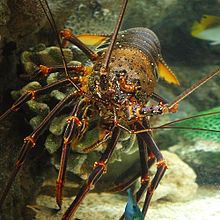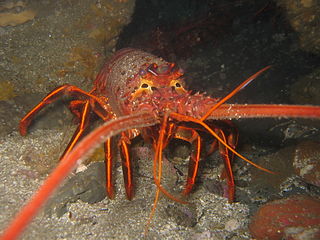
Spiny lobsters, also known as langustas, langouste, or rock lobsters, are a family (Palinuridae) of about 60 species of achelate crustaceans, in the Decapoda Reptantia. Spiny lobsters are also, especially in Australia, New Zealand, Ireland, South Africa, and The Bahamas, called crayfish, sea crayfish, or crawfish, terms which elsewhere are reserved for freshwater crayfish.

The California spiny lobster is a species of spiny lobster found in the eastern Pacific Ocean from Monterey Bay, California, to the Gulf of Tehuantepec, Mexico. It typically grows to a length of 30 cm (12 in) and is a reddish-brown color with stripes along the legs, and has a pair of enlarged antennae but no claws. The interrupted grooves across the tail are characteristic for the species.

Jasus edwardsii, the southern rock lobster, red rock lobster, or spiny rock lobster, is a species of spiny lobster found throughout coastal waters of southern Australia and New Zealand including the Chatham Islands. It is commonly called crayfish in Australia and New Zealand and kōura in Māori. They resemble lobsters, but lack the large characteristic pincers on the first pair of walking legs.

Lobsters are widely fished around the world for their meat. They are often hard to catch in large numbers, but their large size can make them a profitable catch. Although the majority of the targeted species are tropical, the majority of the global catch is in temperate waters.

Panulirus cygnus is a species of spiny lobster, found off the west coast of Australia. Panulirus cygnus is the basis of Australia's most valuable fishery, making up 20% of value of Australia's total fishing industry, and is identified as the western rock lobster.
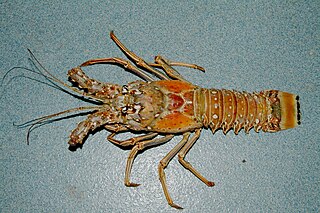
Panulirus argus, the Caribbean spiny lobster, is a species of spiny lobster that lives on reefs and in mangrove swamps in the western Atlantic Ocean.

Panulirus versicolor is a species of spiny lobster that lives in tropical reefs in the Indo-Pacific. Other names include painted rock lobster, common rock lobster, bamboo lobster, blue lobster, and blue spiny lobster. P. versicolor is one of the three most common varieties of spiny lobster in Sri Lanka, alongside Panulirus homarus and Panulirus ornatus.

Jasus lalandii, the Cape rock lobster or West Coast rock lobster, is a species of spiny lobster found off the coast of Southern Africa. It is not known whom the specific epithet lalandii commemorates, although it may the French naturalist and taxonomer Pierre Antoine Delalande.
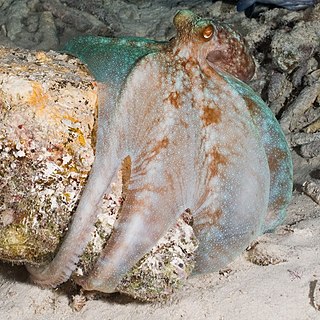
The Caribbean reef octopus is a coral reef marine animal. It has eight long arms that vary in length and diameter. In comparison to the arms, the mantle is large and bulky. This species is difficult to describe because it changes color and texture to blend into its surroundings, using specialised skin cells known as chromatophores. Its color range is very large; it can change from crimson to green, and bumpy to smooth. It weighs around 3.3 lb or 1.5 kg.
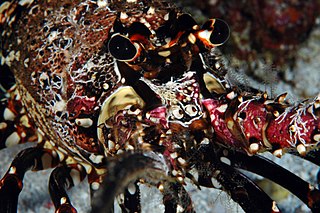
Panulirus marginatus, the Hawaiian spiny lobster, is a species of spiny lobster in the family Palinuridae which is endemic to the Hawaiian Islands. It is the subject of extensive commercial and recreational fisheries.

Scyllarides latus, the Mediterranean slipper lobster, is a species of slipper lobster found in the Mediterranean Sea and in the eastern Atlantic Ocean. It is edible and highly regarded as food, but is now rare over much of its range due to overfishing. Adults may grow to 1 foot (30 cm) long, are camouflaged, and have no claws. They are nocturnal, emerging from caves and other shelters during the night to feed on molluscs. As well as being eaten by humans, S. latus is also preyed upon by a variety of bony fish. Its closest relative is S. herklotsii, which occurs off the Atlantic coast of West Africa; other species of Scyllarides occur in the western Atlantic Ocean and the Indo-Pacific. The larvae and young animals are largely unknown.

Panulirus pascuensis is a species of spiny lobster found around Easter Island and the Pitcairn Islands in the Pacific Ocean. It is known in English as the Easter Island spiny lobster, Langosta de Isla de Pascua in Spanish and Ura in the Rapa Nui language. This lobster is fished on a small scale for local consumption.

Panulirus homarus is a species of spiny lobster that lives along the coasts of the Indian and Pacific Oceans. It lives in shallow water, and feeds on the brown mussel Perna perna. It typically grows to a length of 20–25 cm (7.9–9.8 in). Alongside the dark green nominate subspecies, two red subspecies are recognised, one around the Arabian Peninsula, and one around southern Africa. It is the subject of small-scale fishery.

Panulirus brunneiflagellum is a species of spiny lobster that lives around the Ogasawara Group of southern Japan. Its members were previously included in P. japonicus, although it may be more closely related to P. femoristriga. It has been fished for more than 150 years by Japanese fishermen, who call the species aka-ebi. It differs from related species by the lack of banding along the flagella of the first pair of antennae.

Panulirus ornatus is a large edible spiny lobster with 11 larval stages that has been successfully bred in captivity.
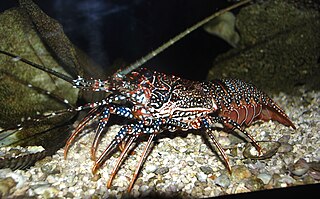
Panulirus guttatus, the spotted spiny lobster or Guinea chick lobster, is a species of spiny lobster that lives on shallow rocky reefs in the tropical West Atlantic and Caribbean Sea.
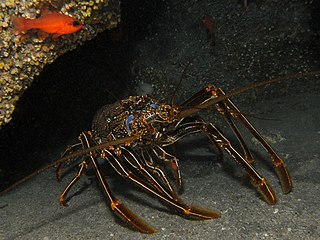
Panulirus echinatus, the brown spiny lobster, is a species of spiny lobster that lives on rocky reefs in the tropical western Atlantic Ocean and central Atlantic Islands.

Panulirus penicillatus is a species of spiny lobster that lives on shallow rocky and coral reefs in the tropical Indo-Pacific region. Common names for this spiny lobster include variegated crayfish, tufted spiny lobster, spiny lobster, Socorro spiny lobster, red lobster, pronghorn spiny lobster, golden rock lobster, double spined rock lobster and coral cray. It has a very wide range and the International Union for Conservation of Nature has assessed its conservation status as being of "least concern".

Panulirus polyphagus, the mud spiny lobster, is a species of crustacean that lives on shallow rocky reefs and muddy substrates in the tropical Indo-Pacific region. The International Union for Conservation of Nature has assessed its conservation status as being of "least concern".

Cinetorhynchus rigens is a species of shrimp in the family Rhynchocinetidae. Common names include mechanical shrimp, Atlantic dancing shrimp, red night shrimp and red coral shrimp. It occurs in shallow water in the tropical Atlantic Ocean.
